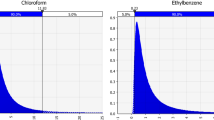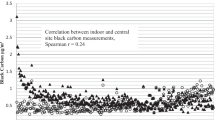Abstract
The Relationship of Indoor, Outdoor and Personal Air (RIOPA) Study was undertaken to evaluate the contribution of outdoor sources of air toxics, as defined in the 1990 Clean Air Act Amendments, to indoor concentrations and personal exposures. The concentrations of 18 volatile organic compounds (VOCs), 17 carbonyl compounds, and fine particulate matter mass (PM2.5) were measured using 48-h outdoor, indoor and personal air samples collected simultaneously. PM2.5 mass, as well as several component species (elemental carbon, organic carbon, polyaromatic hydrocarbons and elemental analysis) were also measured; only PM 2.5 mass is reported here. Questionnaires were administered to characterize homes, neighborhoods and personal activities that might affect exposures. The air exchange rate was also measured in each home. Homes in close proximity (<0.5 km) to sources of air toxics were preferentially (2:1) selected for sampling. Approximately 100 non-smoking households in each of Elizabeth, NJ, Houston, TX, and Los Angeles, CA were sampled (100, 105, and 105 respectively) with second visits performed at 84, 93, and 81 homes in each city, respectively. VOC samples were collected at all homes, carbonyls at 90% and PM2.5 at 60% of the homes. Personal samples were collected from nonsmoking adults and a portion of children living in the target homes. This manuscript provides the RIOPA study design and quality control and assurance data. The results from the RIOPA study can potentially provide information on the influence of ambient sources on indoor air concentrations and exposure for many air toxics and will furnish an opportunity to evaluate exposure models for these compounds.
This is a preview of subscription content, access via your institution
Access options
Subscribe to this journal
Receive 6 print issues and online access
$259.00 per year
only $43.17 per issue
Buy this article
- Purchase on Springer Link
- Instant access to full article PDF
Prices may be subject to local taxes which are calculated during checkout
Similar content being viewed by others
References
Bonanno L.J., Freeman N.C.G., Greenberg M., and Lioy P.J. Multivariate analysis on levels of selected metals, particulate matter, VOC, and household characteristics and activities from the Midwestern states NHEXAS. Appl Occup Environ Hygiene 2001: 16: 859–874.
Caldwell J.C., Woodruff T.J., Morello-Frosch R., and Axelrad D.A. Application of health information to hazardous air pollutants modeled in EPA's cumulative exposure project. Toxicol Ind Health 1998: 14: 429–454.
Chung C.W., Morandi M.T., Stock T.H., and Afshar M. Evaluation of a passive sampler for volatile organic compounds at ppb concentrations, varying temperatures, and humidity with 24-hr exposures. 1. Description and characterization of exposure chamber system. Environ Sci Technol 1999a: 33: 3661–3665.
Chung C.W., Morandi M.T., Stock T.H., and Afshar M. Evaluation of a passive sampler for volatile organic compounds at ppb concentrations, varying temperatures, and humidity with 24-hr exposures. 2. Sampler performance. Environ Sci Technol 1999b: 33: 3666–3671.
Dietz R.N., Goodrich R.W., Cote E.A., and Wieser R.F. Detailed description and performance of a passive perfluorocarbon transfer system for building ventilation and air exchange measurements. In: Trechel H.R. and Lagus P.L., (Eds.) Measured Air Leakage of Buildings. ASTM STP 904 American Society of Testing and Materials, Philadelphia, PA, 1986, pp. 203–264.
Dockery D.W., Pope C.A.I., Xu X., Spengler J., Ware J.H., Fa M., Ferris B., and Speizer F.F. An association between air pollution and mortality in six U.S. cities. N Engl J Med 1993: 329: 1753–1759.
Gordon S.M., Callahan P.J., Nishioka M.G., Brinkman M.C., O'Rourke M.K., Lebowitz M.D., and Moschandreas D.J. Residential environmental measurements in the National Human Exposure Assessment Survey (NHEXAS) pilot study in Arizona: preliminary results for pesticides and VOCs. J Expos Anal Environ Epidemiol 1999: 9: 456–470.
Huang U.L., and Batterman S. Selection and evaluation of air pollution exposure indicators based on geographic areas. Sci Total Environ 2000: 253: 127–144.
Jo W.K., and Oh J.W. Exposure to methyl tertiary butyl ether and benzene in close proximity to service stations. J Air Waste Manage Assoc 2001: 51: 1122–1128.
Jurvelin J., Edwards R., Saarela K., Laine-Ylijoki J., De Bortoli M., Oglesby L., Schlaepfer K., Georgoulis L., Tischerova E., and Haenninen O., et al. Evaluation of VOC measurements in the EXPOLIS study. J Environ Monitor 2001a: 3: 159–165.
Jurvelin J., Vartiainen M., Jantunen M., and Pasanen P. Personal exposure levels and microenvironmental concentrations of formaldehyde and acetaldehyde in the Helsinki metropolitan area, Finland. J Air Waste Manage Assoc 2001b: 51: 17–24.
Kjaergaard S.J., Molhave L., and Pedersen O.F. Human reactions to a mixture of indoor air volatile organic compounds. Atmos Environ 1991: 25a(8): 1417–1426.
Koistinen K.J., Haenninen O., Rotko T., Edwards R.D., Moschandreas D., and Jantunen M.J. Behavioral and environmental determinants of personal exposures to PM sub(2.5) in EXPOLIS — Helsinki, Finland. Atmos Environ 2001: 35: 2473–2481.
Lovett E.G., Verrier R.L., Coull B., Krishna-Murthy G.G., Catalano P., Wolfson J.M., Ferguson E.G., Koutrakis P., Reinisch U., and Godleski J.J. Alteration of canine heart rate variability (HRV) during exposure to concentrated ambient particles (CAPS). Am J Respir Crit Care Med 1999: 157: A260.
Meng Q.Y., Turpin B.J., Korn L., Weisel C.P., Morandi M., Colome S., Zhang J., Stock T., Spektor D., Winer A., Zhang L., Lee J.H., Giovanetti R., Kwon J., Alimokhtari S., Shendell D., Jones J., Farrar C., and Maberti S. Influence of outdoor sources on indoor and personal fine particle concentrations: analysis of RIOPA data. J Expos Anal Environ Epidemiol 2004, in press.
Morello-Frosch R.A., Woodruff R.J., Axelrad D.A., and Caldwell J.C. Air toxics and health risks in California: the public health implications of outdoor concentrations. Risk Anal 2000: 20: 273–291.
Nondek L., Rodler D.R., and Birks J.W. Measurement of sub-ppv concentrations of aldehydes in a forest atmosphere using a new HPLC technique. Environ Sci Technol 1992: 26(6): 1174–1178.
Pellizzari E.D., Clayton C.A., Rodes C.E., Mason R.E., Piper L.L., Fort B., Pfeifer G., and Lynam D. Particulate matter and manganese exposures in Toronto, Canada. Atmos Environ 1999: 33: 721–734.
Pless-Mulloli T., Dunn C.E., Bhopal R., Phillimore P., Moffatt S., and Edwards J. Is it feasible to construct a community profile of exposure to industrial air pollution? Occup Environ Med 2000: 57: 542–549.
Pope C.A. Epidemiology of fine particulate air pollution and human health: biological mechanisms and who's at risk? Environ Health Perspect 2000: 108(S4): 713–723.
Rodes C.E., Lawless P.A., Evans G.F., Sheldon L.S., Williams R.W., Vette A.F., Creason J.P., and Walsh D. The relationships between personal PM exposures for elderly populations and indoor and outdoor concentrations for three retirement center scenarios. J Expos Anal Environ Epidemiol 2001: 11: 103–115.
Rojas-Bracho L., Suh H.H., and Koutrakis P. Relationships among personal, indoor, and outdoor fine and coarse particle concentrations for individuals with COPD. J Expos Anal Environ Epidemiol 2000: 10: 294–306.
Samet J.M., Dominici F., Curriero F.C., Coursac I., and Zeger S.L. Fine particulate air pollution and mortality in 20 US cities, 1987–1994. N Engl J Med 2000: 343: 1742–1749.
Sexton K ., Kleffman D.E ., and Callahan M.A. An introduction to the National Human Exposure Assessment Survey (NHEXAS) and related phase I field studies. J Expos Anal Environ Epidemiol 1995: 5: 229–232.
Singh R.B., Huber A.H., and Braddock J.N. Development of a microscale emission factor model for particulate matter for predicting real-time motor vehicle emissions. J Air Waste Manage Assoc 2003: 53: 1204–1217.
Stock T.H., Morandi M.T., Maberti S.I., and Afshar M. Organic vapor monitor storage study — final report. Submitted to Mickey Leland National Urban Air Toxics Research Center, Houston, TX, 2002.
Suh H.H., Bahadori T., Vallarino J., and Spengler J.D. Criteria air pollutants an toxic air pollutants. Environ Health Perspect 2000: 108: 625–633.
Wallace L.A. Personal exposure, indoor and outdoor air concentrations, and exhaled breath concentrations of selected volatile organic compounds measured for 600 Residents of New Jersey, North Dakota, North Carolina and California. Toxicol Environ Chem 1986: 12: 215–236.
Wallace L.A., Pellizzari E., Hartwell T., Rosenzweig M., Erickson M., Sparacino C., and Zelon H. Personal exposure to volatile organic compounds. Environ Res 1984: 35: 293–319.
Wallace L.A., Pellizzari E.D., Hartwell T.D., Sparacino C.M., Sheldon L.S., and Zelon H. Personal exposures, indoor–outdoor relationship and breath levels of toxic air pollutants measured for 355 persons in New Jersey. Atmos Environ 1985: 19: 1651–1661.
Wallace L.A., Pellizzari E.D., Hartwell T.D., Sparacino C., Whitmore R., Sheldon L., Zelo H., and Perritt R. The TEAM study: personal exposures to toxic substances in air, drinking water and breath of 400 residents of New Jersey, North Carolina, and North Dakota. Environ Res 1987: 43: 290–307.
Zhang J., He Q., and Lioy P.J. Characteristics of aldehydes: concentrations, sources, and exposures of indoor and outdoor residential microenvironments. Environ Sci Technol 1994: 28: 146–152.
Zhang J., Zhang L., Fan Z., and Ilacqua V. Development of the personal aldehydes and ketones sampler based on DNSH derivatization on solid sorbent. Environ Sci Technol 2000: 34(12): 2601–2607.
Acknowledgements
We are grateful to all of the participants in the study. We gratefully acknowledge the hard work of all the students and technicians in the field and laboratories of RIOPA investigators and the hospitality of the RIOPA participants (subjects). Field and laboratory personal included: Qing Yu Meng, Adam Reff, Andrea Polrdori, Robert Porcja, Yelena Naumova, Jong Hoon Lee, Lin Zhang, Tina Fan, Jennifer Jones, L Farrar, Yangrid Blossiers, and Marian Fahrey. This research was supported by The Mickey Leland National Urban Air Toxics Research Center (NUATRC) (Contract # 96-01A/P01818769) and by The Health Effects Institute (HEI, Contract # 98-23-3). HEI is jointly funded by the United States Environmental Protection Agency (EPA: Assistance Agreement R828112) and automotive manufacturers. The contents of this article do not necessarily reflect the views of the Mickey Leland NUATRC nor HEI, nor do they necessarily reflect the views and policies of EPA or of motor vehicle and engine manufacturers. Drs. Weisel, Turpin and Zhang were supported in part by the National Institute of Environmental Health Sciences Center for Excellence (ES05022) and Dr Turpin was supported in part by the New Jersey Agricultural Experiment Station.
Author information
Authors and Affiliations
Corresponding author
Rights and permissions
About this article
Cite this article
Weisel, C., Zhang, J., Turpin, B. et al. Relationship of Indoor, Outdoor and Personal Air (RIOPA) study: study design, methods and quality assurance/control results. J Expo Sci Environ Epidemiol 15, 123–137 (2005). https://doi.org/10.1038/sj.jea.7500379
Received:
Accepted:
Published:
Issue Date:
DOI: https://doi.org/10.1038/sj.jea.7500379
Keywords
This article is cited by
-
Potted plants do not improve indoor air quality: a review and analysis of reported VOC removal efficiencies
Journal of Exposure Science & Environmental Epidemiology (2020)
-
Increased long-term health risks attributable to select volatile organic compounds in residential indoor air in southeast Louisiana
Scientific Reports (2020)
-
Probabilistic estimation of residential air exchange rates for population-based human exposure modeling
Journal of Exposure Science & Environmental Epidemiology (2017)
-
Relationship among environmental quality variables, housing variables, and residential needs: a secondary analysis of the relationship among indoor, outdoor, and personal air (RIOPA) concentrations database
International Journal of Biometeorology (2017)
-
Characteristics of carbonyls and volatile organic compounds (VOCs) in residences in Beijing, China
Frontiers of Environmental Science & Engineering (2016)



